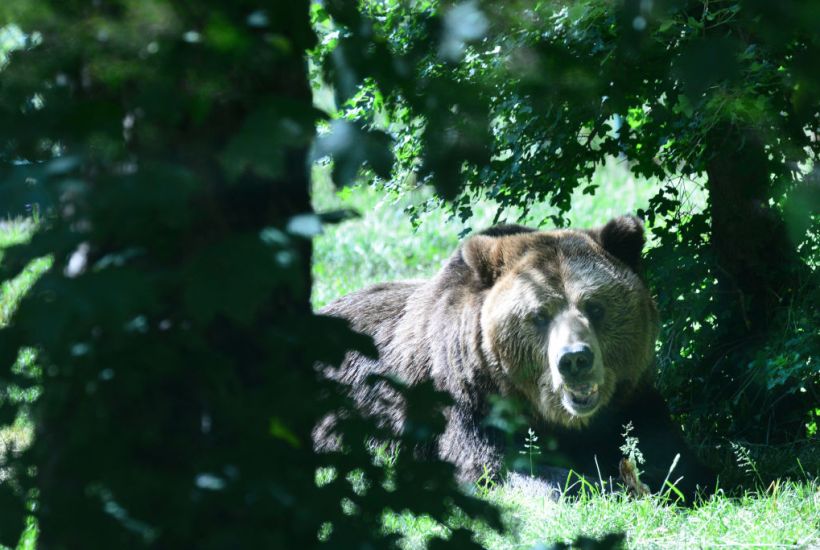The female bear that mauled to death a male jogger in the Italian Alps on 5th April was captured this week.
Twenty-six-year-old Andrea Papi’s ravaged corpse was naked when found. His shirt and shorts lay many yards away. The killer bear, known as JJ4, is a 17-year-old mother of three cubs and the off-spring of two of the ten brown bears brought from Slovenia to the Trentino region of north east Italy in 1999-2000 under an EU rewilding scheme called Life Ursus.
JJ4 was identified as the killer from a DNA match. Two weeks later forestry police captured her after following her tracks in the snow and setting up a tubular bear trap baited with apples coated with honey.
The tragedy prompts two essential questions: should this killer bear be put down? And should such lethally dangerous animals be reintroduced into our countryside, and allowed to breed in an uncontrolled manner?
The answer to the first question is no, probably not, though it is tricky. The answer to the second question is no, definitely not. Sod rewilding.
No, JJ4 should not be sentenced to death. She should instead be given a life sentence in an animal sanctuary. I say this even if no less a bear-lover than Andrea Mustoni, scientific director of Life Ursus, says that would be more cruel than killing her.
And no, obviously, such animals should not be reintroduced, or allowed to breed exponentially, as is happening in Italy not just with bears, but above all with wolves, where both been protected species for decades. Unless, at the very least, we are allowed to shoot bears and wolves on sight. Which we are not.
Where I live – Dante’s Beach in the countryside near Ravenna on the Adriatic coast – we do not yet have bears, but we do have wolves. We see them on the school run from the window of the car and we hear them howling at night. People out walking find the disembowelled remains of fallow deer.
I fear for Peppa, in particular, our children’s donkey, out there in the stables at night, all alone, but also for Rocco our dog, a Hungarian Vizsla, who sleeps in the barn. The traditional habitat of wolves was the Apennines, 40 miles away from us, where they were hunted nearly to extinction. But they are now everywhere, now that they are protected.
It is all very well for the urban elite who live in places like Islington to impose schemes to rewild the countryside with lethal animals, but on Upper Street they run no risk that either they – or their Cavapoochons – will be mauled by a bear or a wolf, do they?
Nevertheless, I think it is wrong to exterminate Italy’s killer bear. I really do. And it is not because my best friend was my teddy bear as a child.
In the case of humans, to prove murder it is necessary to prove intent to kill, and once that’s done, administer a punishment that fits the crime: that acts both as retribution and deterrent. But in the case of JJ4 there was no intent. Bears have no choice. If they feel threatened, they attack. Especially if they are a female, as is JJ4, with cubs in tow. Nor could any punishment meted out to JJ4 deter other bears from attacking humans in the future.
That leaves retribution. In Italy, there is no capital punishment for Italians, so why should there be for bears? Anyway, for retribution to make any sense, the person – or thing – being punished must be aware of why they are being punished and for what. No bear ever can be.
Yes, one element of the justification for retribution is the sating of the public’s desire for revenge. But that only works for humans, For how can you justify exacting revenge on an animal that has no understanding that it has done wrong?
There is also mitigation. JJ4 has three cubs which are about 16 months old and are still with her. Two were caught in the trap along with her but released. Should these three cubs be deprived of their mother?
In Italy, there is no capital punishment for Italians, so why should there be for bears?
It is true that JJ4 has previous. In June 2020, she attacked two hunters, a father and son, badly injuring them.
Maurizio Fugatti, of the right-wing Lega, president of Trentino Alto Adige Region, ordered her death but was over-ruled by the courts after animal rights activists sought judicial review. He has ordered her death this time as well and once again activists have appealed to the courts. A verdict is expected on 11 May. JJ4 meanwhile remains on remand in an animal refuge.
Yet as the jogger’s mother says: ‘It is not my son’s fault but nor is it the bear’s.’ And as his father says: ‘Symbolic vendettas don’t interest us.’ But those in charge of the management of the bears, he adds, must accept ‘moral responsability’ for his son’s death.
What he is driving at, without spelling it out, either because unable or unwilling, is this: those who introduced these bears to his mountains are to blame for his son’s death. Nevertheless, the dead jogger’s parents are surely correct. It serves no purpose killing an animal that has killed a human being.
A few months ago, for instance, in the hills above Rimini, not far from me, an 84-year-old man died after being bitten by a viper while mowing the lawn. What would be the point of killing the viper? Just lock it up.
The brown bear population in the Trentino has grown from ten when the EU project began in 1999 to about 120. These bears are quite capable of travelling 20 miles a day. Several, such as JJ4, are classified as ‘problematic’.
The Trentino can handle only half that number – says Fugatti – who pledges by hook or by crook that he will halve their number. ‘For too many years we have concentrated on the problems of the bears and not those of our community. It’s high time we reversed that,’ he says.
On this he is surely right. Problematic bears include MJ5, an 18-year-old male bear which in March attacked a 39-year-old man who was out walking with his dog and is still on the loose. Videos are regularly posted on social media of what these bears are getting up to such as strolling nonchalantly along high streets, forcing entry to pasticcerie to devour biscotti and brioche, and climbing up onto the balconies of blocks of flats.
Bears strip vineyards of grapes, kill sheep and cows, and demolish beehives. Yet animal rights activists want JJ4 released back into the wild with her three cubs and moved somewhere more remote. This is crazy given the huge distances bears can travel and the likelihood that JJ4 will find her way back to the area where she lived.
The most ridiculous animal rights activist comment came from Ornella Dorigatti, local delegate of the Organizzazione Internationale per la Protezione degli Animali. She told a talk-show that if you come across a brown bear all you need to do to scare if off is to ring a small silver bell which she duly brandished in front of the television cameras.
‘JJ4 must return to the woods with her cubs,’ she said. Yet not even Andrea Mustoni, scientific director of Life Ursus, agrees. He is ruthlessly clear: problematic bears such as JJ4 must be put down. ‘Condemning them to death inside a refuge, filled with drugs, is uselessly cruel. Only eliminating them if they get too close to man (…) can we preserve their presence in the Alps,’ he says.
But that, dare I say it, is coldly clinical and inhumane. Let JJ4, mother of three, live. In a sanctuary. It is not perfect but it is better than exterminating her, isn’t it? Meanwhile, basta bears. Basta! Move the lot. To Rwanda. If necessary.
Meanwhile, having said all this, in the Apennines of the Abruzzo, not far from Rome, Italy’s other bear population poses no threat to human beings. These southern bears are native Italian bears – the orso bruno marsicano – and different to the Slovenian ones introduced in the north. So harmoniously does this Italian bear co-exist with Italian people that one of them regularly emerges from the woods to stop off at the ice cream parlour in a small town where the owner gives him a gelato which he demolishes in 30 seconds. And then off he goes back to the woods.
Got something to add? Join the discussion and comment below.
Get 10 issues for just $10
Subscribe to The Spectator Australia today for the next 10 magazine issues, plus full online access, for just $10.




















Comments
Don't miss out
Join the conversation with other Spectator Australia readers. Subscribe to leave a comment.
SUBSCRIBEAlready a subscriber? Log in